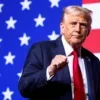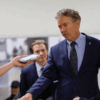When economists forecast the economy, they tend to draw straight lines. They figure out where we are and where we’re going, and they plot a line. In fact, neither contractions nor expansions are ever smooth. For various anomalous reasons in the economy and in the data, reported GDP movements are jagged. The reported economy accelerates, slows down, jumps, and pauses. So one ought to hesitate before reading too much into the latest economic data. However …
The recent report on second quarter growth showing a reasonably strong 2.4 percent pace was, as usual for a first read, based on incomplete data. It many respects, the economists and statisticians at the Commerce Department’s Bureau of Economic Analysis do a great job offering an educated guess. But as the more recent trade data for June suggest, this guess was a bit off.
The June data showed a surprising bulge in the monthly U.S. trade deficit to almost $50 billion. If that figure holds up, then the updated reading on second quarter GDP will likely come down to just over 1 percent. That’s weak growth, but still growth. However …
The second quarter saw another big jump in inventories, which counts as business investment and raises GDP. In fact, inventory gains accounted for more than half of the growth reported in the fourth quarter of 2009 and the first of 2010. The inventory gain in the second quarter of 2010 accounted for 1 percentage point of growth.
The second quarter also saw a very strange 0.9 percent contribution from increases in government spending—federal defense, non-defense, even state and local spending. Something like a 0.1 percent increase would have been more normal.
Combined, inventories and a one-time surge in government spending accounted for 1.9 percent of the just over 1 percent growth. Put another way, the trend for the private sector was to contract in the second quarter. This could just be part of the unevenness of economic expansions. However …
Combine this with rising first-time unemployment claims, rising housing foreclosures, an about-face by the Fed signaling its worries about the economy, “signs of a dramatic slowing in the Chinese economy”, and a broad deterioration of consumer and business confidence, and what could be an economy catching its breath looks more and more like an economy catching a serious cold.
There’s not much Washington policymakers can do at this point to address many of these economic forces, but they can do a lot to begin to restore some confidence in America’s economic future. Restore confidence and businesses will dust off those now-shelved expansion plans.
How can Washington restore confidence? Jawboning won’t do. Washington has to demonstrate with concrete actions that the nation’s policymakers have a clue.
- Raise taxes on a faltering economy? They haven’t got a clue.
- Spend so much the nation faces trillion-dollar deficits for a decade? They haven’t got a clue.
- Pour on new regulatory burdens? They haven’t got a clue.
- Fall asleep on advancing free trade? They haven’t got a clue.
- Bail out teachers unions while driving our most competitive companies and their jobs overseas? They haven’t got a clue.
With this record, the nation has a pretty good clue why confidence is fading and the economy is faltering.































